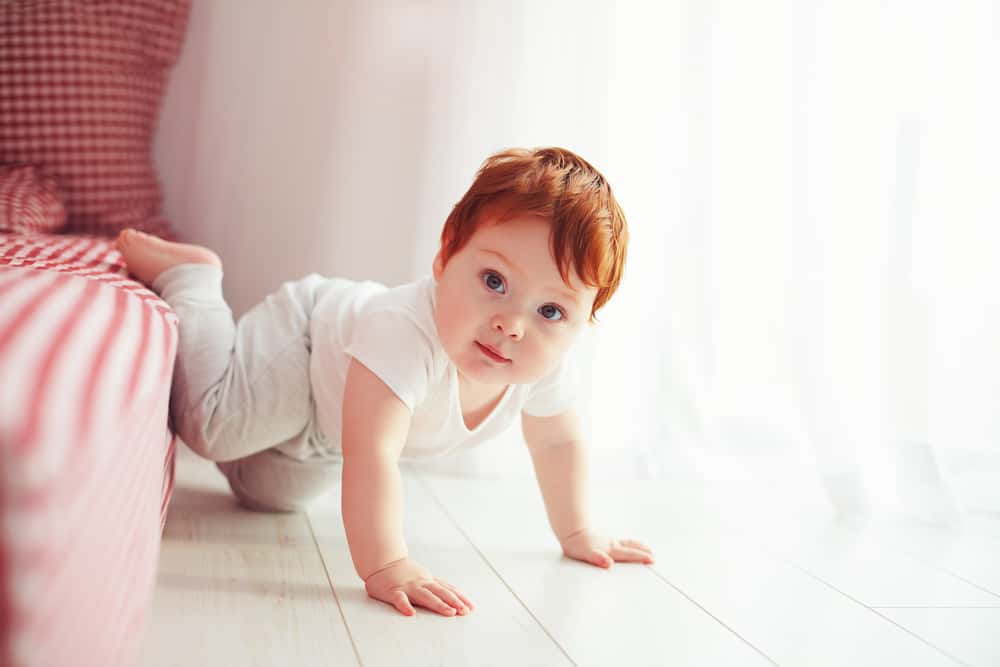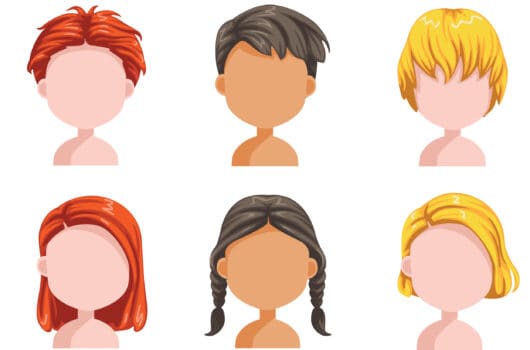Working out the hair color of your baby is easy.
You just look at their head.
Problem solved. Article over. Thank you.
But in all seriousness, there are some genetic things you need to take into consideration to get an idea of the probabilities of your unborn baby’s hair color. It’s not always an exact science, but you can take a good guess of what your baby’s hair color might be.
- Baby’s Hair Color and Genes
- When Is Hair Color Determined?
- How Alleles Affect Hair Color
- Pigment and the Hair Color of Your Baby
- Can the Color of My Baby’s Hair Change?
- What Are the Chances That My Baby Will Have Red Hair?
- What Are the Chances That My Baby Will Have Black Hair?
- How Likely Is Albinism in Babies?
- Can I Figure Out the Hair Color of My Baby?
Baby’s Hair Color and Genes
Unsurprisingly, your baby’s hair color is determined by your baby’s genes. And those genes are determined by your genes and the genes of your partner, which are in turn determined by your parents’ (and your partner’s parents’) genes.
Assuming you know the hair color of both parents and both sets of grandparents, you can have a good guess of what the hair color of your baby will be.
With this child’s traits calculator, you can input biological traits of these six people to calculate the biological traits which your baby will have. You can estimate its predicted hair color, eye color and type of ear lobes. The calculator also works out the likelihood of your kid having dimples, a cleft chin and a widow’s peak.
When Is Hair Color Determined?
From the very moment a sperm and egg meet, every one of a child’s biological traits is determined. From that very moment, a child’s hair color, eye color and everything else have already been set in stone.
Eggs and sperm are clever. Every single egg has 23 chromosomes from the mother (which is half of the mother’s total of 46 chromosomes). Every sperm cell has 23 chromosomes from the father (which, again, as you’ve probably guessed, is half of the father’s total of 46 chromosomes).
Upon fertilization, the egg and sperm combine to make up 46 chromosomes, which will determine what the child looks like. These chromosomes determine hair color, eye color, sex, personality traits, blood type and much more.
But back to the hair color.
How Alleles Affect Hair Color
Although we know how hair color is influenced and determined, we still can’t always predict exactly what the hair color of your baby will be. It’s a little more complicated than just 46 chromosomes, since each chromosome contains hundreds or thousands of genes.
That’s a lot of genes, leaving us with almost-endless genetic combinations when you combine the genes of two different people. So, yes, we can make predictions, but few of them are absolute.
For example, if two people have a kid, that kid might not have the same eye color or hair color as their parents. Similarly, no two siblings ever look exactly the same, so there’s obviously lots of wriggle room inside the whole equation.
Predicting Baby’s Hair Color
It gets even more complicated. Inside every single one of a baby’s genes is two alleles. One comes from the baby’s mother, and one comes from the baby’s father. But some alleles are dominant, and some alleles are recessive.
Alleles that lead to darker eyes and hair, for example, are usually dominant, which is why there are more dark-haired, dark-eyed people in the world, compared to how many light-eyed, light-haired people there are.
If, for example, a brown-haired person has a baby with a blond-haired person, it’s more likely that they’ll have a brown-haired child than a blond-haired child. If both parents have brown hair, the child will likely (though not necessarily) have brown hair. If two blond parents have a child, that child will absolutely have blond hair.
Dominant and Recessive Alleles
That’s all because some alleles are recessive, and some are dominant.
If a blond-haired person had any brown-haired alleles, then they would have had brown hair, not blond hair. So a blond-haired person does not have any dark-haired alleles. That means that between them, two blond-haired parents have absolutely no dark-haired alleles, and only blond-haired alleles. And that means that they can only pass blond-haired alleles onto their unborn child.
Let’s take a look at the situation where two brown-haired parents have a blond-haired child. That seems unlikely, and it is mathematically unlikely. But if both parents have the recessive blond trait, and their baby receives both these alleles in their genetic makeup, the baby will have blond hair even though neither of their parents do. Weird, right?
Again, the best way to have a good guess is by using a genetic calculator that takes into account the hair color of the baby’s parents along with the hair color of both sets of grandparents.
The further back you go in the genetic chain, the easier it becomes to make a good prediction, as it becomes easier to calculate which recessive genes may or may not be present. But you won’t find a calculator that goes back fifty generations, because no-one has time for that.
Pigment and the Hair Color of Your Baby
Our hair looks the way it does because of the pigment it has in it. You’ve probably heard of pigment, a word that refers to certain colors in certain chemicals. The pigment which affects our skin color and hair color is melanin (and you’ve probably heard of that too).
Melanin is present in both our hair and skin, and there are two types of it. The first is eumelanin, which is responsible for causing darker tones, while pheomelanin is responsible for causing lighter tones. If you have more eumelanin than pheomelanin in your hair, you’ll have darker hair. If you have more pheomelanin than eumelanin, you’ll have lighter hair.
Can the Color of My Baby’s Hair Change?
Yes, it can. Lots of kids are born with a certain color hair, which changes into another color as they get older. Lots of kids are born with blond hair, only for that hair to get darker as they get older. It’s pretty common for kids both with red or blond hair to then end up having brown hair as an adult.
Often, kids experience a surge in eumelanin as they grow older, resulting in darkening of the hair. This can happen in infanthood, childhood and even early adolescence.
Hair is very changeable. Most babies are born bald, but that doesn’t mean they’ll stay that way. Likewise, a baby that comes out looking like they’ve got a wig on won’t necessarily stay that way either.
What Are the Chances That My Baby Will Have Red Hair?

Generally speaking, the chances are pretty low. Depending on who you ask, somewhere between 1% and 2% of the world’s population have red hair. But it’s obviously more likely in some places than others.
The chances of a red-haired person being born in Scotland, for example, is higher than the chances of a red-haired person being born in say, Kenya.Again, that’s because of the traits of the child’s parents.
Like the blond hair gene, the red hair gene is recessive, so both parents must have that gene in order for it to be passed on. If both parents are redheads themselves, they’ll absolutely have a redhead baby. That’s because they only have redhead genes, so they can only pass those genes on.
But again, it’s possible for two non-redhead parents to have a redhead baby. But for that to happen, they’ll both need to carry a recessive redhead gene, so it’s pretty unlikely that such a thing would happen.
What Are the Chances That My Baby Will Have Black Hair?

Relatively, the chances are pretty high, as black hair is the world’s most common hair color. Again, it’s more likely in some regions than others, but around 75% of the world’s inhabitants have black (or very dark brown) hair.
If both parents have black hair, or dark hair, there’s a good chance that their baby will have black hair or dark hair. But it’s possible that both parents still possess the recessive blond allele, or the recessive redhead allele. If they do, and they both pass that allele on to their unborn child, that unborn child will have blond hair or red hair, no matter how unlikely that might seem.
How Likely Is Albinism in Babies?
It’s actually a little more common than you probably think. Up to 1 in 100 of the general population might be carriers of the albino gene. But again, that doesn’t always mean they’ll pass it on, just as a person with the blond hair gene might not pass on blond hair.
Around 1 in 19,000 US kids have albinism, but rates are much higher in other parts of the world.
The chances of albinism hugely vary according to where you’re from and where you live. It’s most common in Sub-Saharan Africa, and in people who have heritage from that area. In parts of the world where albinism is common, there’s thought to be around a 1 in 3,000 chance that a kid will be born with it.
Remember that melanin stuff we were talking about before? A person with albinism has a lack of it, and therefore has very pale skin and hair. And as you’ve probably guessed, if your child has albinism, none of the other genetics matter when it comes to hair color, because they’ll definitely have white hair.
Again, albinism is rare, and is a recessive gene – so both parents need to carry the gene in order for a child to be born with albinism.
Can I Figure Out the Hair Color of My Baby?
It’s (usually) not an exact science, but you can make some good estimations.
If (like we keep saying!) you use an online hair color calculator, you can make a good guess, leaving you with a decent idea of the color of the hair that’ll be spurting out of your baby’s skull. But in most cases, you’ll never know for sure – and the color of their hair might even change as your kid grows.
If both parents have red hair, you’ll have a redhead baby. If both parents have blond hair, you’ll have a blond baby. But beyond that, there are no absolutes, and you can only take a good guess.
For more information on these genetic predictions and likelihoods (and for the visual learners among you), this video is great.
There you have it! Everything you need to know about the hair color of your baby. Now you don’t have to lose your hair over worrying about the color of your baby’s hair.
